- Home
- William Shatner
Shatner Rules Page 13
Shatner Rules Read online
Page 13
Well, maybe. But if you’re eighty, chances are you’ve at least picked up a few rich experiences along the way and have some opinions and passions.
I’m going to eschew the format of Shatner Rules for a bit and get serious about some serious stuff. No more rules, no more joking around.
How can I do that, you ask?
RULE: If You Make the Shatner Rules, You Get to Break the Shatner Rules
What do I want to talk about as we break format?
Well, the thing I’m more than always happy to talk about is horses.
A.k.a. Equus ferus cabbalus, the large, hooved mammal that man has been domesticating for more than six thousand years, and a creature that has enchanted me for most of my life.
I have horses here in California, and I have them at my home in Kentucky. I keep them in both places. Seriously, horses are a real bitch to get into your carry-on.
For more than twenty years now, I have organized the Hollywood Charity Horse Show, where world-class reining horses and riders compete for top honors before a standing-room-only crowd. This year, we even live-streamed the event all over the world, an event that was topped off with a fantastic performance by Sheryl Crow. All the money we raise goes to my favorite charities, and to advance the science of hippotherapy.
Hippotherapy is a method of treating mental and physical handicaps with the sensory effects provided by interaction with horses. Often, it involves introducing mentally handicapped children to the wonders of the animal, wonders that elicit emotional responses from kids who don’t respond to traditional therapy.
You wouldn’t believe the transformation that takes place when some of these kids are placed atop an animal. Lately, Elizabeth has been spearheading an effort to bring hippotherapy to wounded veterans of our wars in Iraq and Afghanistan. Horses bring out the best in people, and they certainly bring out the best in me.
Also, if you are lucky enough to attend one of my Hollywood Charity Horse Shows, you will see me in a cowboy hat and boots. And you’ll see me on horseback, competing in the reining events.
Reining is like figure skating on horseback, but without all the sequins. Although sometimes there are sequins—there’s nothing wrong with being a little showy in the horse world. Reining is a competition where a horseman shows his skill in maneuvering the horse, doing what the cowboys did when driving cattle and herding calves.
Calves move fast, and they might dart to the right or to the left, so the cowboy might have to turn 180 degrees in either direction very fast on his horse. Figure skating has the double axel and the rocker foxtrot, while reining has the sliding stop, the rollback, the fast and slow circles, the change of leads. I practice these patterns every day when I’m riding, and I’ve become one of the top amateur reiners in the country.
Now, many actors have hobbies that take them out of the world of acting, and hobbies that have a tendency to take over their lives. My old friend and mentor Edward G. Robinson had a massive collection of abstract and impressionist art. Leonard Nimoy has all but abandoned acting for photography. Half the vehicles on the road in the city of Burbank belong to Jay Leno. (And Jay—can you put some turn signals on that Stanley Steamer? You nearly ran me off Ventura Boulevard the other day, damnit!)
Horseback riding won’t take over acting, but to me, riding a horse is just like acting. As an actor, you need to forget your techniques; they must become second nature. The same thing goes for riding: The techniques of balance, placement of feet, where your hands are, where your mind-set is—it all vanishes when you enter the realm of horse riding. Like acting, horse riding is about seamless communication.
As an actor, if you know the words intrinsically, they’re part of you. Once I’m up and going in a scene, I am no longer thinking of the words; I’ve got the words. You have to ride with this state of complete unity with the horse. You’re into that Zen state of mind, body, and purpose. I have felt on numerous occasions that the horse’s head and legs are my head and legs. I merely have to think and the horse does.
Would I give up acting to be with the horses full time? Of course not. I would never want horses to become my job. That would take the fun out of it.
And honestly, acting pays for the horses.
RULE: Being Eighty Means That You Can Abruptly Change the Subject While Speaking, and People Will Follow
While I’m taking advantage of my elder statesman free rein, let’s talk about the real rain. And how much acid is in it.
My own mortality is something that keeps me awake at night, but so does the mortality of this planet.
Heavy? Okay. But not as heavy as the destruction of the world.
When I first got concerned about the environment, there was no jumping on the Hollywood bandwagon. Back then, the bandwagon was a one-seater, and I felt like the only one along for the ride. I read Rachel Carson’s Silent Spring—the book that all but launched the modern American environmental movement—back in 1962, and it scared the living hell out of me. It should scare the living hell out of you, too. Especially those of you younger than eighty—you’re gonna be stuck with this mess on Planet Earth longer than I will be.
Back in 1962, I would even try to bring up the environment in interviews, only to have reporters give me that “this is never going into my piece” look. I often felt like my character in the classic Twilight Zone episode “Nightmare at 20,000 Feet.” I was shouting about impending disaster, but no one was listening. And the threats to our planet were and are much more severe than any from a man wearing a rubber suit shuffling around on an airplane wing.
Eventually, more people got on board over the years, and I try to be optimistic, but it takes more than sorting your recyclables and bringing your own bag to the grocery store. I fear we’re doomed, and that within my grandchildren’s lifetime, the conditions on our planet will be horrendous. And the main fight will be over water, not oil.
There are even potential disasters that aren’t our doing. I’ve become acquainted with the fact that Yellowstone is rising. There’s a giant magma bubble under Yellowstone that could blow at any moment, and if that were to happen, it would affect the whole of the western part of the United States. The potential for chaos and the Four Horsemen of the Apocalypse is only too real.
The destruction of the planet, and the lack of seriousness that our public representatives seem to be taking toward this destruction, troubles me deeply. We are not demanding their action. It is the nature of man to avoid thinking painful thoughts. We are naturally gifted in avoiding pain, whether it’s physical or mental.
(NOTE: Another abrupt subject change ahead. I’m allowed. This is important.)
This brings me back to my interest in mindful meditation, the thing that helps me get through a busy, four-Shatner day. Meditating: taking a moment to relax, allowing your muscles to unwind, to free your mind, to allow the thoughts to come, to focus on your breathing. I accept my fear for the world, and accept my resolve to do something about it, to warn others.
Mind you, all this meditation business doesn’t mean that I’m “mellow.” Not by any stretch. I still get a visceral feeling of anger when I see somebody throwing trash out the window of a car—a frequent sight here in Los Angeles.
When I see that, I will often drive up as close as I can to the driver and glower at them. If there’s one benefit of living for eighty-plus years, it’s that you’ve had plenty of time to work on your scowl. Unfortunately, the objects of my anger soon recognize the face that is expressing disdain, and then roll down their window, ask for an autograph, and herald, “Beam me up, Scotty!” That’s when they get the one-finger salute. After I give them the autograph.
I’ve been lucky enough to witness some of the more majestic sights nature has to offer and I want them to stay majestic. What can I say?
The foot of Mount Everest is one such majestic sight. In addition to some spectacular v
istas of nature, this place also offers a glimpse into your soul.
I was in the Himalayas, sometime in the 1980s, staying at an ancient Buddhist temple, and I was looking for the spiritual epiphany that I’ve yearned for all my life. I’ve searched for it in my own way. Where are we going? What is life? What is the ultimate meaning of it all?
Like many before me, I felt the answer lay thousands of feet above sea level, in the freezing cold, with barely any plant life. There is also no air at all up that high on Everest—I would wake up at night, gasping for breath. Of course, I was sleeping outside.
That’s right, the path to enlightenment does not involve a Sleeper King Suite at the Holiday Inn. Every evening, I would wrap myself up in the sleeping bag and sit outside in the dark night, waiting for the spirits of the mountains to enter my body or enter my soul or enter my consciousness, to speak to me in some manner.
And I’d wait day after day, night after night—and . . . nothing . . . until the wee hours of my last night in the bitter cold on the barren mountainside. I was leaving the following day, and I’d given up on making the big connection. I was sad. And shivering.
And suddenly, I was hit with an overwhelming wave of perception, a blinding flash of realization. I had finally acquired . . . the truth. My soul was opened and I was enlightened, and the enlightenment was this: that there exists nowhere on Earth a “soulful place,” but that all, everywhere you are, is the soulful place. I could achieve what the Buddhist monks were trying to achieve in that valley at the confluence of Mount Everest and all those other holy mountains—wherever I was.
This entire world is filled with mystical qualities, including my little slice of the world, with its horses and dogs and loved ones, and that paradise and enlightenment are always within my reach. It’s joy. And you should work on filling all your years with as much joy as possible. Even if you make it all the way to eighty and beyond.
Although honestly, I wish that wave of perception had come to me on the first night in Tibet. I would have hotfooted it to the nearest resort as soon as possible. Enlightenment can arrive in a hot tub, too.
CHAPTER 22
RULE: If You Go to the Land Down Under, Thumb It!
I should say that I’m not talking about hitchhiking. Australia is in the middle of nowhere, and it also contains thousands of square miles of nowhere in the middle of it. You do not want to get stuck without a lift in the bush—with or without a cardboard TWO MCGILL STUDENTS sign. A random dingo will gladly eat your baby, you, and whatever spare family members might be hanging around. You’ll be down under, all right—six feet under!
RULE: Get the Australia Jokes out of the Way Early—Everyone’s Heard ’Em Already
Australia is a rough-and-tumble nation full of wonderful, rough-and-tumble people. Open, loving, friendly, beautiful people. An Australian production company pitched me the idea of a touring night of anecdotes and stories, I agreed, and soon visited the great country in the spring of 2011 with my one-man show, Kirk, Crane and Beyond: William Shatner Live. ($#*! My Dad Says was also very popular there, but I thought the title Kirk, Crane, and Other $#*! might be a little too rough-and-tumble for even Australia.) Elizabeth and I happily made the journey to the faraway land, albeit one that felt slightly longer than my hitchhike across America as a teenager.
Kirk, Crane and Beyond: William Shatner Live was a two-hour-long program that featured me, a moderator (usually a local television or radio personality), tons of film clips, audience questions, and questions from the Twitterverse. We did shows in Sydney, Brisbane, and Melbourne, and then swung up to Auckland, New Zealand, to do a show there. In between, I also made it to a couple of Star Trek conventions. They are smaller than the American conventions, but people still come in costume. You can even hear Klingons sizing up one another’s weapons à la Crocodile Dundee:
“Here—that’s not a bat’leth. That’s a bat’leth!”
Of course, when I perform live nowadays, like I did with Kirk, Crane and Beyond, it’s not just jokes and anecdotes and questions answered. It’s also songs!
And what do you sing when you tour Australia? Well, I know AC/DC heralds from down under, and perhaps on the next trip I will treat the crowd to my cover of “Hell’s Bells,” but during this tour, I performed two Australian classics: “Down Under,” by Men at Work, and the unofficial national anthem, “Waltzing Matilda.”
“Waltzing Matilda,” in particular, was a real treat. It’s the tale of a man in the bush, making a cup of tea, who poaches a sheep for his supper. When the authorities come to arrest him, he drowns himself in a water hole, and then haunts it for all eternity. (Actually, given its darker themes, perhaps AC/DC should do a cover of that song themselves.)
We decided to do “Waltzing Matilda” on the last show of the tour. There was no rehearsal, just me, a music stand, and our musical director on piano. He played, I interpreted, and the crowd ate it up. I really played up the drama of the song, and got to wrap my melodious diction around the following Australian words:
Swagman
Billabong
Jumbuck
Coolibah
I have to say that “billabong” and “coolibah” were my favorites, and I really . . . took . . . my . . . time . . . with . . . them.
(NOTE TO THE AUSTRALIANS IN THE AUDIENCE: I hope I pronounced all of the above properly, and I hope none of these terms are actually Australian curse words. If so, I’m sorry for all the obscenity.)
As you might be able to tell from my last-minute interpretation of one of Australia’s most beloved songs about billabongs, there was a great deal of working “without a net” on Kirk, Crane and Beyond: William Shatner Live. Improvising and riffing in front of an audience is one of my favorite things to do, and after a season of performing comedy live in front of a studio audience on $#*! My Dad Says, it is something I’d grown to relish.
But when working without a net, you sometimes forget there’s a possibility that you might land on the hard concrete. Concrete soaking wet with fine, Australian beer. And it was at my Sydney show that I encountered an audience member who apparently thought Kirk, Crane and Beyond would be better after twelve or thirteen cans of Foster’s Lager.
During our Q&A segment, people would step up to a microphone and ask whatever was on their mind. But at one point, some guy in the crowd starts shouting, “I got a question! Me, I got a question!” I told him to quiet down and wait his turn, but nothing doing.
In all my comedic experiences, this was the first time I’ve ever been heckled.
What are the typical responses to a heckler? I know there’s always the reliable “Ahh, yes. I remember my first beer.” But this was Australia—most people there experience their first beer from a plastic bottle with a nipple on it. That razor-sharp retort wouldn’t work.
I’ve also heard, “I don’t go to your job and knock over the Slurpee machine.” Would Australians know what a Slurpee was? They know what a jumbuck is—they must have heard of a Slurpee.
Either way, before I could prepare a fittingly acerbic bon mot, he yelled out again, “I have a question!”
I yelled, “No, don’t do that. You paid too much money for you to be talking and me to be talking. Let me do the talking. Also, there’s a microphone. That’s where you ask the questions.”
RULE: When in Doubt, Go with the “Slurpee Machine” Comeback
Unfortunately, he stood up and began to lumber toward the mic. All six foot four inches of him. I was having Lee Van Cleef flashbacks. I was beginning to wonder if the organizers of a one-man show featuring an eighty-year-old actor had had the foresight to hire a security team.
He slurred, “My question is [unintelligible].”
Seriously. I couldn’t understand what this deranged character was saying. He could have been shouting “Billabong!” for all I knew. (And for the purposes of recounting this story, I’ll replace
[unintelligible] with “billabong.”)
I figured there was no assuaging him. “So what’s your question?” I asked, hoping to keep him in the audience.
“Billabong,” he sputtered, stepping on the feet of all the people in his row as he made his way toward the aisle. I figured it was time to get stern, take command, and negotiate. Give the crowd a dose of Kirk and Crane.
“Why don’t you just sit back down and take it easy? Don’t come this way because now you’re being threatening.”
He wasn’t listening, and started walking down the aisle toward the stage. Kirk and Crane weren’t cutting it. Time to go with Hooker.
“Do not come up on my stage.”
Perhaps he’d never seen T.J. Hooker, because that’s just what he did. And he began to shuffle toward me. What if he has a gun? I thought to myself. Since he was Australian, I just assumed he already had a knife on him. How on Earth was I to defuse this situation?
Lose Crane, Hooker, and just go full-on fighting Kirk? Without all the stuntmen backing me up? I knew some judo from the old days, had some knowledge of jujitsu, trained briefly in Krav Maga. Which discipline should I use to handle this sodden Aussie? One? Two? All three?
Or perhaps I could employ the ancient marital art of Running Away?
I sensed then that the moderator had gotten up and faded back to obtain the services of a police officer. I was grateful, but also thinking that William Shatner should handle any crisis that emerges during a William Shatner one-man show. A constable was procured, however.
As the cop began to head over to my visitor, I said, “No, leave him alone; it’s okay,” just as Mr. Billabong reached me on stage.
Once more with the Hooker.
“Sit down!” I snapped. And he obediently sat down.
Very obedient. Perhaps his inability to articulate came from being part dog? I didn’t want to push my luck with “roll over,” but it was tempting.

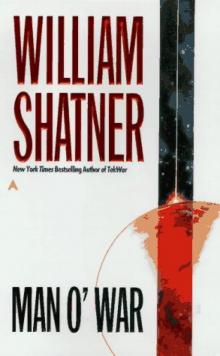 Man O' War
Man O' War Shatner Rules
Shatner Rules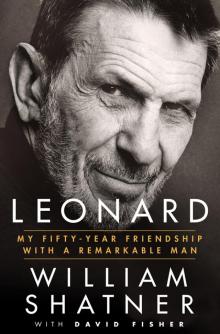 Leonard
Leonard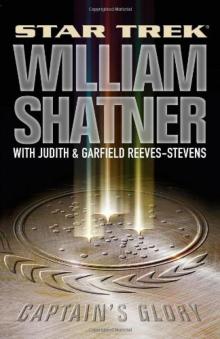 Captain's Glory
Captain's Glory Captain's Glory зпвш-9
Captain's Glory зпвш-9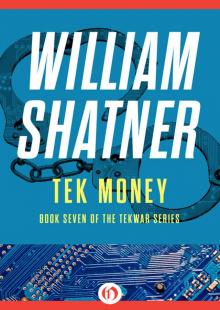 Tek Money
Tek Money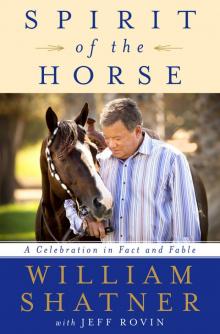 Spirit of the Horse
Spirit of the Horse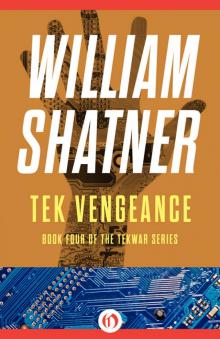 Tek Vengeance
Tek Vengeance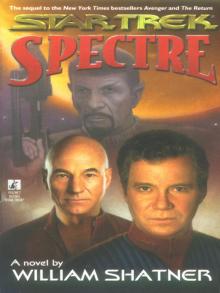 Spectre
Spectre Zero-G
Zero-G Tek Kill
Tek Kill Collision Course
Collision Course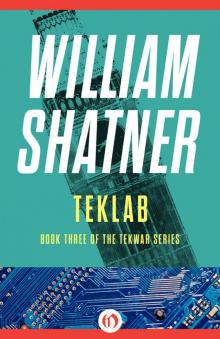 TekLab
TekLab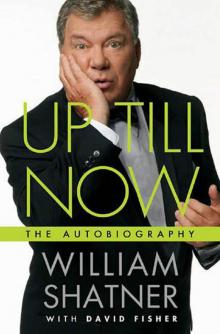 Up Till Now
Up Till Now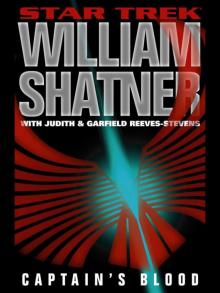 Captain's Blood
Captain's Blood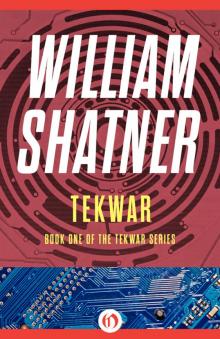 TekWar
TekWar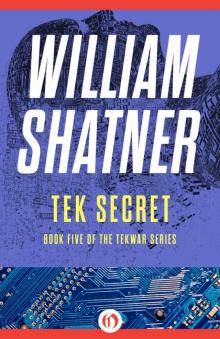 Tek Secret
Tek Secret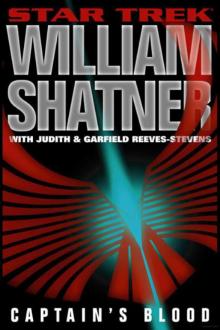 Captain's Blood зпвш-8
Captain's Blood зпвш-8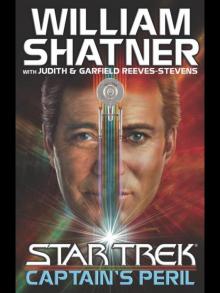 Captain's Peril
Captain's Peril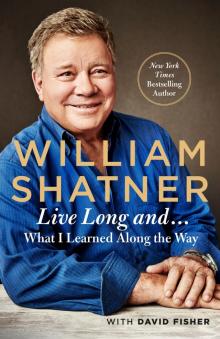 Live Long and . . .
Live Long and . . .